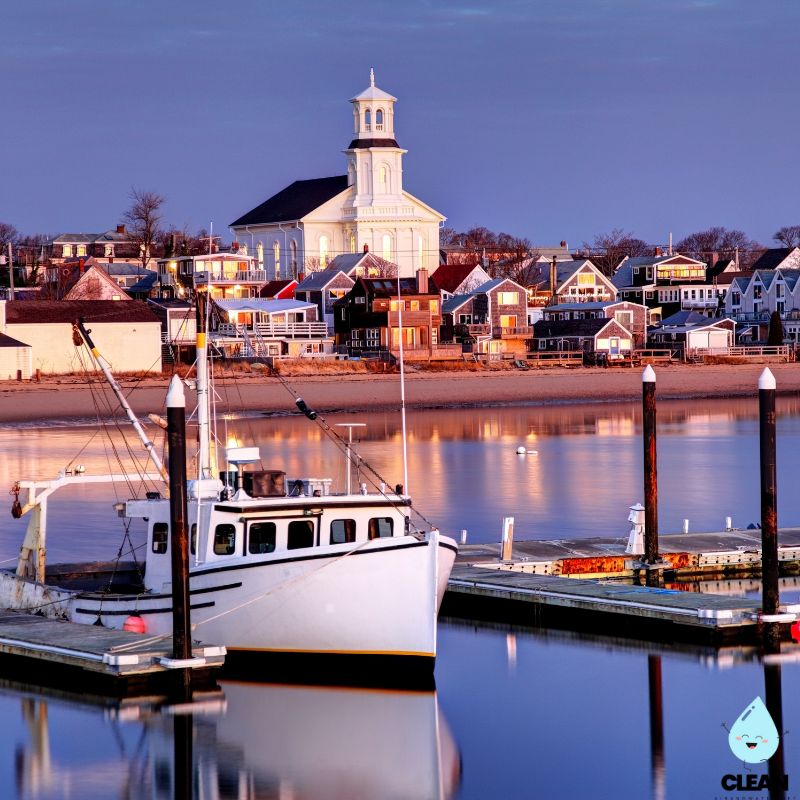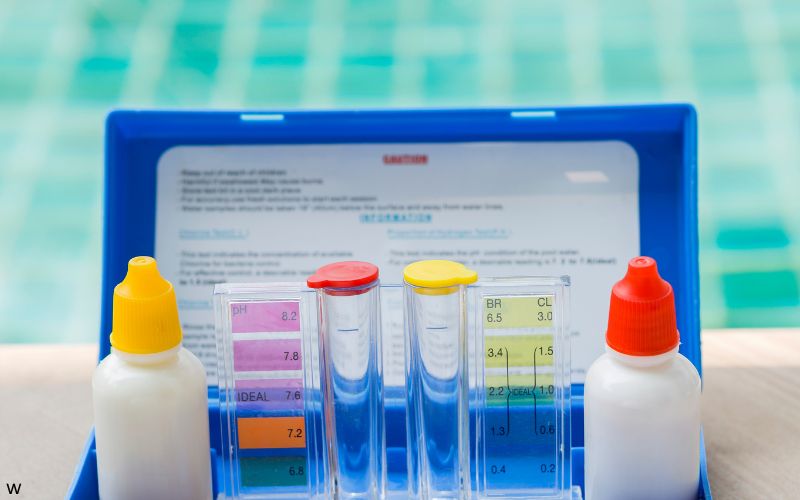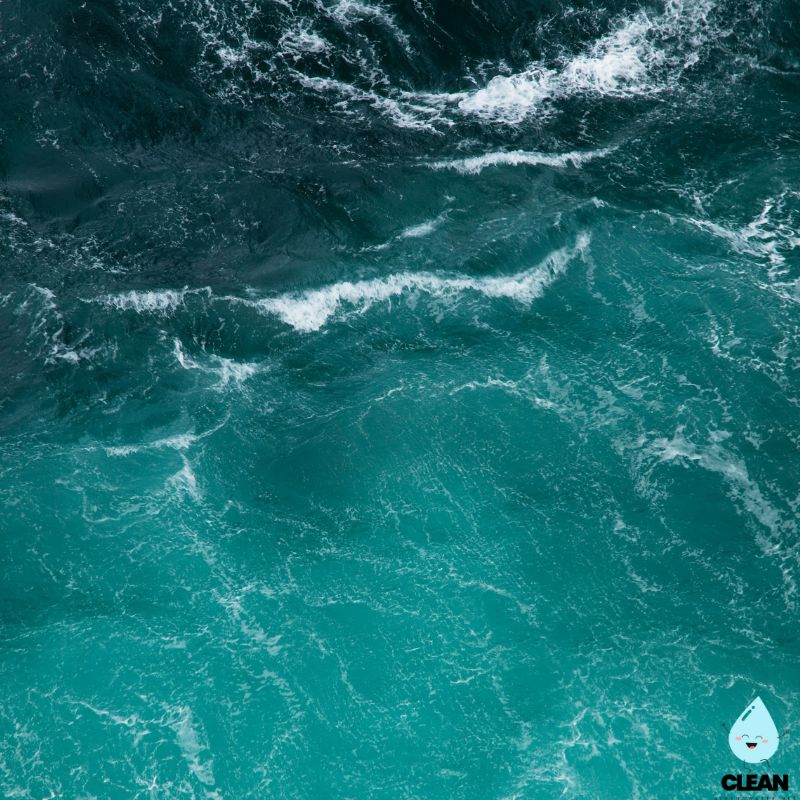Cape Cod Water Quality at a Glance
major PFAS concerns
Is Cape Cod Water Safe to Drink?
Public Systems Generally Good, Private Wells Risky – Most Cape Cod public water systems meet standards and receive “excellent” or “good” ratings, but severe PFAS contamination from military bases and fire training areas threatens the sole-source aquifer. Private wells particularly vulnerable, with some areas showing PFAS levels 225 times the state standard near Hyannis fire training academy.
⚠️ Key Concerns for Cape Cod Residents
- PFAS “Forever Chemicals”: Extreme contamination from Joint Base Cape Cod and fire training facilities affecting Hyannis, Mashpee, Falmouth areas
- Sole Source Aquifer: No alternative water source for 200,000 year-round and 500,000 summer residents makes contamination especially dangerous
- Private Wells at Risk: Over 3,600 private wells lack PFAS testing requirements, many likely contaminated
- Military Legacy Pollution: Decades of firefighting foam use at bases created persistent groundwater contamination plumes
Read the full report below for detailed analysis, town-specific data, and actionable recommendations for Cape Cod residents.
Cape Cod – Massachusetts – Water Quality Report 2025: PFAS Testing, Infrastructure Concerns & Safety across your city
Cape Cod’s water systems comprise a decentralized network of 21 public water suppliers serving over 200,000 year-round residents and up to 500,000 seasonal visitors. Unlike many urban areas, Cape Cod relies almost exclusively on groundwater from the sole-source Cape Cod Aquifer, a pristine underground reservoir formed by glacial deposits that provides nearly 100% of the region’s drinking water. This fragmented system includes approximately 1,800 miles of water mains across 15 townships, with individual water districts drawing from over 160 public supply wells reaching depths of 100-400 feet into the aquifer.
Cape Cod’s drinking water originates from precipitation that filters through sandy soils into the underlying aquifer, naturally protected by the Cape Cod National Seashore and various conservation lands. The region’s water has historically been known for its exceptional purity, requiring minimal treatment compared to surface water systems. However, Cape Cod faces unique challenges including saltwater intrusion due to its peninsula geography, nitrate contamination from septic systems, and severe PFAS contamination from military activities. The various water districts have implemented innovative treatment technologies, monitoring programs, and public education campaigns to address these issues while preserving the naturally high quality of the aquifer.

Cape Cod Water Quality: Current Status (2024-2025)
Latest Testing Results
- PFAS Levels: PFAS contamination varies dramatically across Cape Cod, with some areas showing levels 225 times the state standard near military fire training sites in Hyannis, while many public water systems maintain levels below detection limits through advanced treatment.
- Testing Scope: Cape Cod water suppliers collectively conduct over 75,000 water quality tests annually, with expanded monitoring for emerging contaminants including quarterly PFAS testing at all public supply wells since 2020.
- Compliance Status: All Cape Cod public water districts currently meet federal Safe Drinking Water Act standards, with 19 of 21 receiving “excellent” ratings and 2 receiving “good” ratings based on 2023 Consumer Confidence Reports.
Protected Aquifer System
- Sole-Source Aquifer: The EPA-designated Cape Cod Aquifer provides 100% of the region’s drinking water, composed of six lens-shaped groundwater cells floating above denser saltwater, serving as the only water source for 200,000 year-round and 500,000 summer residents.
- Natural Filtration: Soil composition provides excellent natural filtration, with groundwater typically extracted from depths of 100-400 feet after decades of natural purification through sandy glacial deposits.
- Watershed Protection: Over 100,000 acres of protected land including National Seashore, state forests, and local conservation areas help maintain source water quality through development restrictions and buffer zones around wellheads.
Treatment Technologies
- PFAS Treatment: Multiple Cape water districts have installed granular activated carbon (GAC) and ion exchange treatment systems at affected wells to remove PFAS compounds, with Hyannis Water System leading implementation after severe contamination from nearby fire training facilities.
- Minimal Disinfection: Most Cape systems use minimal chlorination due to the naturally protected groundwater source, resulting in lower disinfection byproduct formation compared to surface water systems.
- Emerging Solutions: Pilot programs testing advanced oxidation processes and biofiltration specifically designed for Cape Cod’s unique water chemistry and contaminant profile, with focus on PFAS removal technologies.
Infrastructure Challenges
- Saltwater Intrusion Monitoring: Extensive monitoring network with sentinel wells to detect early signs of saltwater intrusion from rising sea levels and increased pumping during tourism season, particularly critical given the peninsula geography.
- System Expansion: Strategic extension of municipal water service to areas previously reliant on private wells that show vulnerability to PFAS contamination, prioritizing areas near Joint Base Cape Cod and fire training facilities.
- Climate Resilience: Infrastructure upgrades to protect water supplies from coastal flooding and storm surge, with elevated wellheads and flood-resistant pump station designs to protect the sole-source aquifer.
Community Protection Initiatives
Cape Cod’s water districts offer comprehensive community support including subsidized PFAS testing for private well owners (over 3,600 wells lack mandatory testing), filter rebate programs for affected households, and water conservation incentives to protect the aquifer. The Cape Cod Water Protection Collaborative coordinates regional response to water quality threats, while educational programs engage residents and seasonal visitors in source water protection. The region’s strong environmental ethos has fostered innovative approaches to managing emerging contaminants, with particular focus on early detection and transparent communication. Despite seasonal population fluctuations placing stress on water infrastructure, Cape Cod’s ongoing investment in aquifer protection and treatment technologies helps preserve this critical natural resource while addressing legacy contamination from military activities.
Recommendations for Cape Cod Residents

Test Your Well Water
Private well owners should test annually for PFAS, nitrates, and volatile organic compounds. Contact your town health department or the Barnstable County Health Department for subsidized testing programs. PFAS testing is especially critical given severe contamination near military sites.

Install PFAS Filtration
If PFAS is detected in your water, install NSF-certified activated carbon or reverse osmosis filtration systems. Point-of-entry (whole house) systems recommended for high contamination areas. Contact local water departments about available rebate programs.

Conserve Water
Protect the sole-source aquifer by installing water-efficient fixtures, limiting outdoor irrigation, and timing high-volume water use for off-peak hours. Rebates for WaterSense appliances available through most water districts.

Maintain Septic Systems
Properly maintain your septic system with pumping every 3-5 years and avoiding harsh chemicals that can contaminate groundwater. Consider nitrogen-reducing technologies to protect the aquifer and coastal waters.

Report Water Concerns
Contact your local water department immediately for water quality issues or service disruptions. For regional concerns, the Cape Cod Commission Water Resources program provides coordinated response at (508) 362-3828.
Quality News About Your Water
Get the comprehensive water quality news coverage you need with our dedicated US Water News Service. From coast to coast, we deliver in-depth reporting and expert analysis on PFAS contamination, EPA regulatory changes, infrastructure developments, and emerging water safety issues affecting communities nationwide. While mainstream media only covers the biggest stories, we provide the detailed, ongoing coverage that helps you understand the full scope of America’s water challenges. Whether you’re a concerned citizen, water professional, or community leader, our daily updates and analytical insights keep you informed about the issues that matter most to public health and environmental safety.
Frequently Asked Questions
Is Cape Cod’s tap water safe to drink?
Public water supplies on Cape Cod generally meet all federal drinking water standards, with 19 of 21 systems receiving “excellent” ratings and 2 receiving “good” ratings. The region’s groundwater source provides naturally high-quality water that requires minimal treatment compared to surface water systems.
However, Cape Cod faces severe PFAS contamination from decades of military firefighting foam use, with some areas showing levels 225 times the state standard. Public water districts have implemented treatment where needed, but approximately 20% of Cape residents rely on private wells that lack mandatory PFAS testing. Private well owners should test regularly, especially those near Joint Base Cape Cod, fire training facilities, or airports. If contamination is detected, certified filtration systems can effectively remove PFAS.
Why are PFAS chemicals a concern on Cape Cod?
PFAS (per- and polyfluoroalkyl substances) are synthetic “forever chemicals” that don’t break down naturally. Cape Cod faces severe PFAS challenges due to:
1. Decades of firefighting foam use at Joint Base Cape Cod and Barnstable County Fire/Rescue Training Academy, creating some of the highest contamination levels in the country
2. Highly permeable sandy soils that allow contaminants to travel easily to the sole-source aquifer serving 200,000 year-round and 500,000 summer residents
3. Legacy contamination that will persist for decades without active remediation
Massachusetts has adopted a protective PFAS6 standard of 20 ppt (federal standard is 4 ppt for individual compounds). PFAS health concerns include developmental effects, immune system impacts, and potential links to certain cancers with long-term exposure. The situation is being actively addressed through ongoing cleanup efforts and advanced treatment systems.
How does Cape Cod address seasonal water demand?
Cape Cod’s population swells from about 200,000 year-round residents to over 500,000 during summer months, creating unique water management challenges for the sole-source aquifer:
• Tiered rate structures: Higher water rates during peak usage periods incentivize conservation
• Seasonal pumping strategies: Water districts rotate well use to prevent localized aquifer drawdown and saltwater intrusion
• Storage infrastructure: Most districts maintain elevated storage tanks to meet peak demand periods
• Outdoor water restrictions: Implemented from May through September to limit non-essential use
• Saltwater intrusion monitoring: Increased vigilance near coastal wells during peak pumping season
These combined strategies help maintain aquifer levels and water quality despite significant seasonal population fluctuations, protecting Cape Cod’s only water source for future generations.
What outdoor water restrictions exist on Cape Cod?
Cape Cod implements seasonal outdoor water use restrictions to protect the sole-source aquifer during peak demand periods:
Standard Seasonal Restrictions (May-September):
• Odd/even day watering based on street address
• No irrigation between 9am-5pm when evaporation is highest
• Hand watering of gardens and new plantings generally permitted
Drought Response Tiers:
During drought conditions, additional restrictions may include:
• One-day-per-week watering schedule (Mild Drought)
• Hand watering only for established landscapes (Moderate Drought)
• Complete ban on outdoor watering (Severe Drought)
Restrictions vary by water district, with current status available through local water department websites and the Cape Cod Commission’s WaterWatch portal.
Contaminants of Concern

PFAS
Source: Firefighting foam from Joint Base Cape Cod and Barnstable County Fire/Rescue Training Academy creating severe contamination hotspots; additional sources include consumer products, landfill leachate, and wastewater from septic systems
Health Effects: Developmental effects in children, immune system suppression, thyroid disruption, elevated cholesterol, and potential links to certain cancers with long-term exposure
Current Status: Levels range from non-detect in treated systems to 225 times state standard (4,500 ppt) near fire training areas MA DEP Limit: 20 ppt for sum of six PFAS compounds; Federal MCL: 4 ppt for PFOA/PFOS individually

Saltwater Intrusion
Source: Overpumping of wells near coastlines, especially during peak summer season when population triples, combined with sea-level rise causing the saltwater-freshwater boundary to move inland through the peninsula’s permeable soils
Health Effects: Increased sodium intake can affect those with hypertension or other health conditions requiring sodium restriction; corrosive effects on plumbing systems
Current Status: Early indicators detected in some coastal wells during peak summer demand; strategic pumping schedules and monitoring networks implemented to prevent significant intrusion into the sole-source aquifer
Please read – our information
The information presented on cleanairandwater.net is compiled from official water quality reports, trusted news sources, government websites, and public health resources. While we strive for accuracy and thoroughness in our presentations, we are not scientists, engineers, or qualified water quality professionals.
Our mission is to present water quality information in an accessible, real-world format that helps people understand what’s in their water and make informed decisions about their health and safety. We believe that complex environmental information should be available to everyone in a format that’s easy to understand.
We make every effort to ensure our content is current and accurate, but we cannot guarantee that all information is complete or error-free. This website should not replace official communications from your local water utility or health department. We always recommend consulting official sources for the most up-to-date information regarding your specific water system.
Clean Air and Water is not liable for any unintentional errors, omissions, or outdated information. The content on this site is provided for informational purposes only and should not be considered professional advice.


